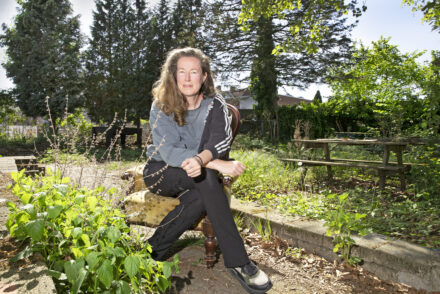The university is Catholic, but students and staff hardly notice
It is no longer in the name, but it is still true: Tilburg University is a Catholic university. That was all well and good in its founding year, 1927, when there were still Catholics who went to church. But what should the university do with its Catholic roots now?

The history of Tilburg University actually begins in Nijmegen. In the early twentieth century, the Dutch bishops felt that Catholic emancipation was incomplete without its own university. That university was established in 1923, when the Roman Catholic University Nijmegen was opened.
This was against the wishes of Thomas Goossens and Jos Cobbenhagen, who at the time were just men and not buildings. They wanted Tilburg to join the march of scientific nations. And they succeeded. Four years later, on August 29, 1927, the R.K. Handelshoogeschool (Roman Catholic Business School) came into being, focusing on economic science, something Nijmegen did not have at the time.
60 years of Univers
Univers has been around for sixty years. Since 1964, a lot has happened at the university, and Univers has reported on it. This year we are diving into our archives. How does history repeat itself on campus? And how did we, as a university paper but also as a university, get to where we are now?
The educational institution started with fifteen students, but growth and ambition were already evident. This became clear five years later when the school, which was housed in the city center, received a subtitle: ‘School for Economic and Social Sciences.’
This was later shortened to Catholic School of Economics. In 1963, the university, now with a law faculty, found a new home in Building A, now the Cobbenhagen building. This happened at a new location, near the Warandebos, and with yet another new name: Katholieke Hogeschool Tilburg (Catholic School Tilburg).
The ‘C’ of Catholic
In 1985, the school was even allowed to call itself a university by the education minister. The new name became Katholieke Universiteit Brabant (KUB, Catholic University Brabant), because using Tilburg would result in an awkward abbreviation. And so much changed in academic Tilburg during the twentieth century, except for the ‘C’ for Catholic, which remained in the name.
Univers also underwent some changes. Until that time, the newspaper was still called Tilburgs Hogeschoolblad (THB). But that name was no longer appropriate. A new name was introduced: Univers. University, but without the ‘ity’. It is also the name of a font. Ironically, Univers does not use that font itself, but the university does. It is the standard font for all university publications.
The new name KUB raised some questions. The ‘rich Catholic life’ was already a thing of the distant past, at least for the new generations of students. More and more of them did not know the dry taste of communion wafers and were unfamiliar with baptismal fonts, first communion, and confirmation. The question was increasingly raised: what do we still need the ‘K’ for in KUB?
The ‘C’ for Character
The Catholic aspect in the name of the university has often been a topic of discussion. It was frequently written about in the old THB and later in Univers. In 1977, the celebration of the university’s tenth lustrum provided a reason to examine that ‘K’ more closely.
In the report from THB, it is noted how the chairman of the board, Jan Verster, raised the question of who is actually responsible for the Catholic character of the university: the people who work there, or the Catholics who founded it?

According to Rector Magnificus Hendrik Jeukens, the whole issue was much ado about nothing; the school had an open Catholic character, and the influence of the church on science was minimal. According to him, this influence was limited to the Foundation Board (the supervisory board) appointed by the bishops, which was only responsible for appointing new members and overseeing amendments to the statutes.
In fact, in addition to watching over the Catholic identity, Jeukens believed the Foundation Board should also safeguard the independence of the school: ‘both from the state and from the church.’
Away with the ‘C’
Should the university be called Catholic forever? That is not the case. As of September 2002, the new name became Tilburg University, still in Dutch at the time. The ‘C’ did not disappear entirely but was retained in the subtitle: ‘inspired by the Catholic tradition.’
The university remains Catholic, although students and staff hardly notice. There is a Foundation Board, a prayer at the beginning of academic ceremonies, and at the start of the academic year, there is a Catholic mass adorned by the banners of the disputations of the Tilburg student corps, Olof.
The ‘C’ connection
Yet the ‘C’ in the new century is not entirely without meaning, as evidenced by a Univers special on the ‘C’ connection. Thanks to the ‘C’, the university is part of national and international Catholic networks and makes important contacts there. ‘An example of this is the All Saints’ Conference, where the bigwigs of Catholic Netherlands come together.’
And the Catholic identity also attracts religious scholars. One such figure is the Reformed lawyer and CDA Member of Parliament Alis Koekkoek. He has no problem with the Catholic signature. In fact, when he was a member of the first university council in the early 1970s, this was already a topic of discussion: ‘Sometimes I thought I was one of the few left defending the Catholic label.’
Another researcher who appreciated the ‘C’ in 2000 was Wim van de Donk, now Rector Magnificus, then a 38-year-old professor of Societal Public Administration. ‘Although I could work at a non-Catholic university, the KUB was a conscious choice for me. We have just a little more to define our mission: the Catholic aspect here is also a measure and a compass.’






